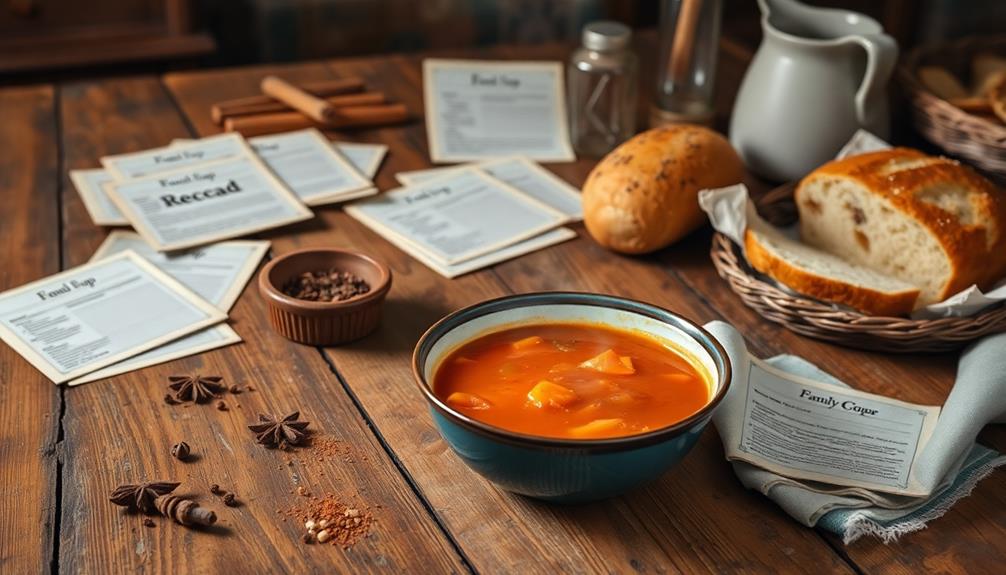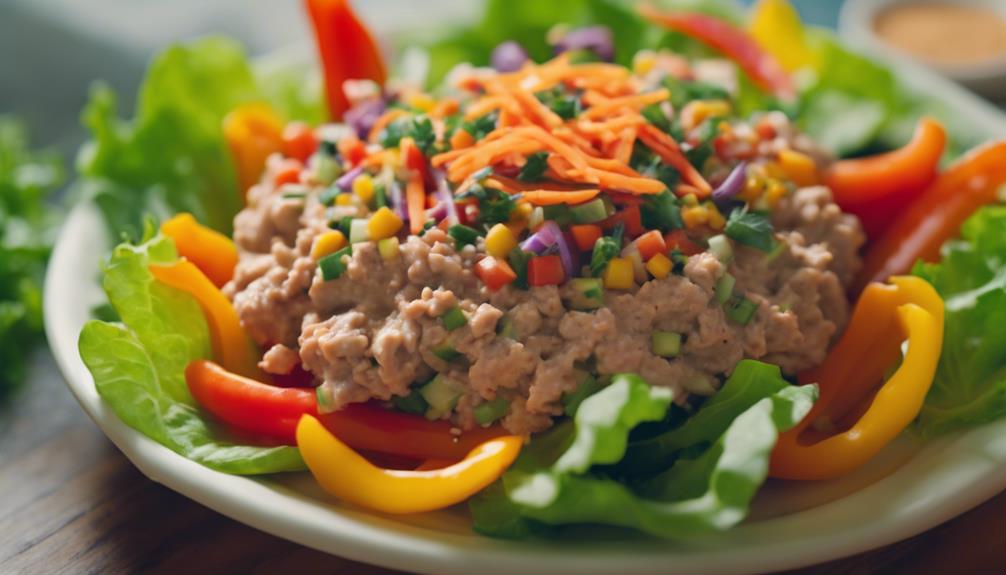Certain foods are considered aphrodisiacs because they're linked to enhancing sexual desire and pleasure. Oysters, for example, are rich in zinc, which boosts testosterone production. Dark chocolate contains compounds that promote feelings of happiness, while chili peppers increase blood flow. Beyond their nutritional benefits, cultural beliefs and rituals surrounding these foods add to their allure. Foods that resemble human anatomy often get attributed with aphrodisiac properties. The psychological effect also plays a role—believing a food is an aphrodisiac can enhance your experience. You'll discover even more fascinating insights about these foods and their effects on intimacy.
Key Takeaways
- Certain foods are linked to sexual desire due to their historical and cultural significance, such as oysters and chocolate celebrated in various traditions.
- Nutritional components like zinc in oysters and antioxidants in berries contribute to hormone production and improved blood circulation, enhancing sexual health.
- Foods with sensual shapes or associations, like figs or bananas, evoke attraction and emotional connections, reinforcing their aphrodisiac reputation.
- The psychological belief in aphrodisiac effects can create a placebo effect, influencing perceived enhancement of sexual desire and pleasure.
- Some foods are considered aphrodisiacs due to their ability to stimulate mood and ambiance, which play a significant role in sexual desire.
Definition of Aphrodisiacs
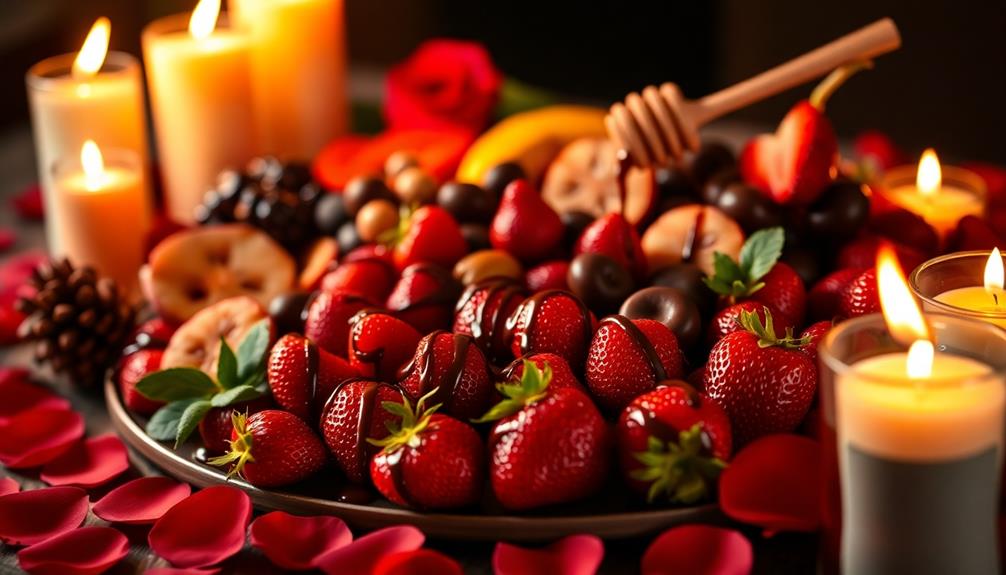
Aphrodisiacs are intriguing substances, often found in foods or herbs, that many believe can enhance sexual desire and pleasure. The term derives from Aphrodite, the Greek goddess of love, highlighting the link between these substances and romance.
You might encounter three main types of aphrodisiacs: those that boost sexual desire, enhance fertility, and increase sexual pleasure. Certain dishes like Red-Braised Pork Belly and spicy components such as chili peppers are often thought to add excitement to romantic meals, enhancing the overall experience.
Common examples include oysters, chocolate, and chili peppers, each thought to have unique properties that impact libido. However, it's essential to recognize that scientific evidence supporting these claims is limited, and much of what you hear is based on anecdotal experiences.
Cultural perceptions play a significant role in defining what qualifies as an aphrodisiac. Foods are often associated with eroticism or fertility, influenced by their shape or nutritional content.
For example, some might consider foods that resemble reproductive organs or those rich in vitamins and minerals as aphrodisiacs. Ultimately, while certain foods are celebrated for their supposed aphrodisiac qualities, the psychological factors surrounding them can often be just as influential as their physical effects on sexual desire.
Historical Significance and Cultural Beliefs
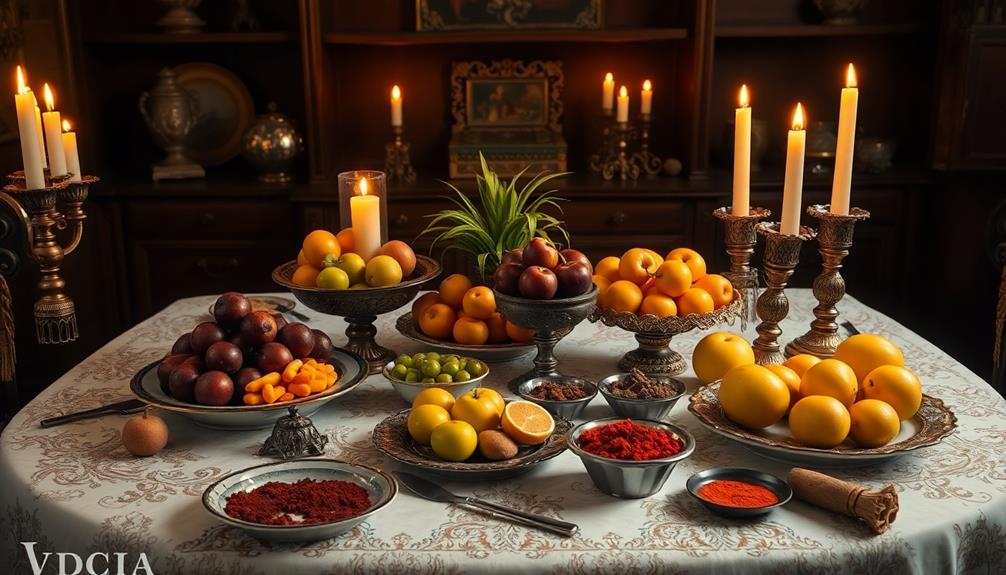
Throughout history, various cultures have celebrated specific foods as powerful enhancers of sexual desire and performance. The term "aphrodisiac" itself derives from Aphrodite, the Greek goddess of love, highlighting the deep-rooted connection between food and romance.
Different cultures, from the Romans to the Egyptians, documented the use of aphrodisiac foods, believing certain ingredients could boost libido and improve sexual performance. Oysters in Europe and ginseng in Asia were particularly revered for their supposed potency.
In Brazilian culture, for instance, ingredients like coconut, found in desserts such as Brigadeiro, are often associated with indulgence and romance, enhancing their allure as aphrodisiacs a blend of cultural influences.
Interestingly, many cultural beliefs attribute aphrodisiac properties to foods that visually resemble human anatomy. Figs and bananas, for instance, have been thought to evoke sexual imagery, reinforcing their status as enhancers of desire.
Rituals surrounding the consumption of these foods during celebrations or romantic occasions have also been widespread, further entrenching the belief in their power.
These historical practices and beliefs illustrate how cultures have intertwined food and sexuality, creating a fascinating legacy that continues today. As you explore aphrodisiac foods, you'll find that the stories and traditions behind them deepen your appreciation for their role in intimate experiences.
Nutritional Components of Aphrodisiac Foods
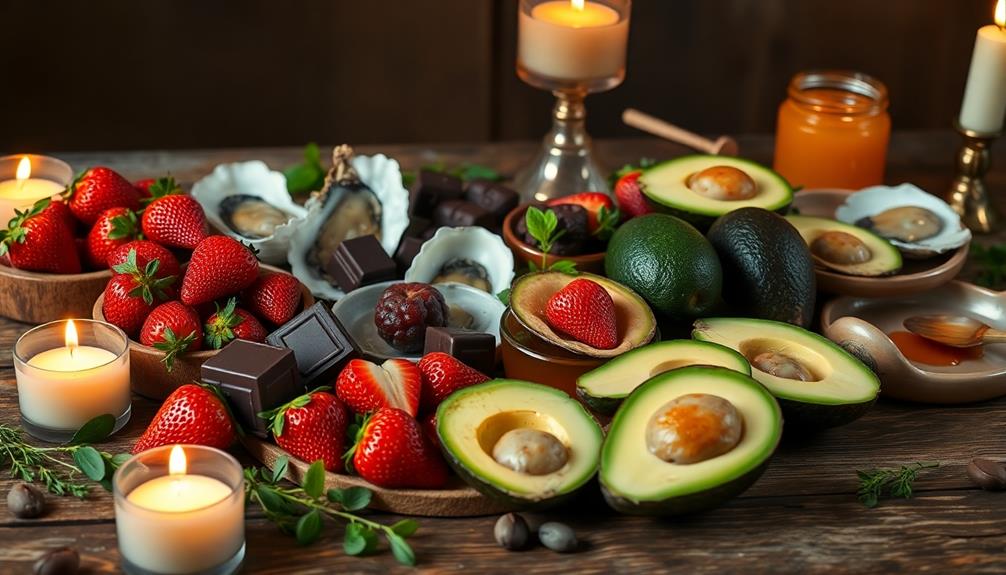
When it comes to enhancing your intimate experiences, the nutritional components of various foods play a significant role. Foods rich in zinc, like oysters and pumpkin seeds, are vital for testosterone production, boosting libido for both men and women. For instance, incorporating dishes like Muamba De Galinha can introduce flavorful ingredients that are beneficial for sexual health. By integrating these zinc-rich options into your diet, you can help elevate your sexual desire.
Additionally, amino acids found in figs and bananas support hormone production and increase your sexual stamina. Antioxidants, particularly from berries and pomegranates, improve blood circulation, which can enhance your sexual function by promoting better blood flow to the genitals. This increased circulation can lead to heightened sensitivity and arousal.
Don't forget about healthy fats, which are essential for hormone production and overall sexual health. Avocados are a fantastic source of these healthy fats and vitamin E, making them a great addition to your meals.
Popular Aphrodisiac Foods
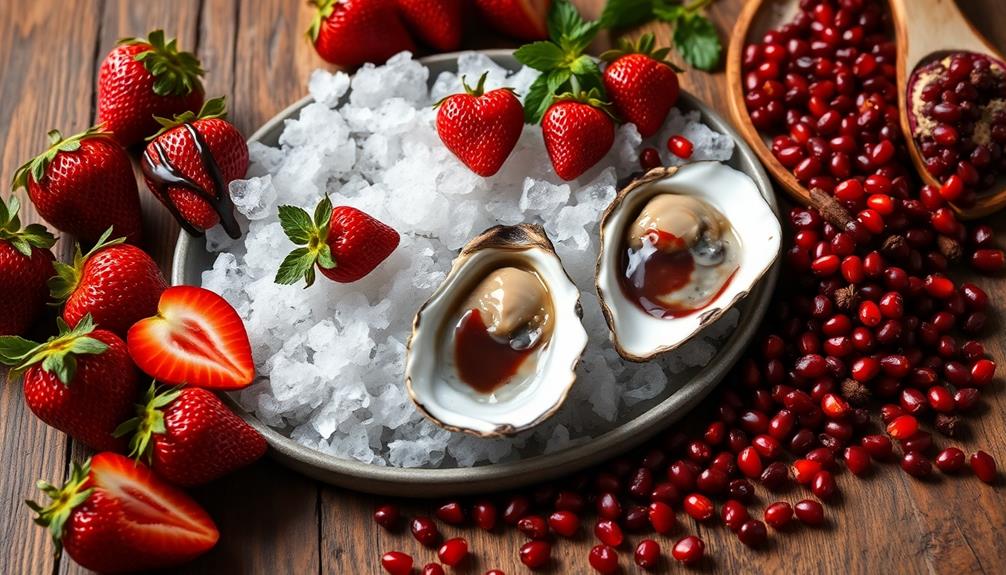
When you think about popular aphrodisiac foods, certain items like oysters, dark chocolate, and chili peppers probably come to mind. Each of these foods brings unique nutritional benefits and cultural significance, which can influence your mood and desires.
Curiously, certain holiday leftovers like turkey can also be creatively transformed into dishes that serve as comfort food, enhancing the romantic atmosphere during intimate meals, such as a Turkey Sandwich made from leftover Thanksgiving turkey. Pairing such a dish with a warm, candlelit setting can evoke a sense of coziness and connection, perfect for a quiet evening together. There’s something uniquely satisfying about utilizing leftovers to craft new meals, and it’s often said that why leftovers sometimes taste better is due to the flavors having extra time to meld and intensify. This infusion of flavors can transform a simple turkey sandwich into a delightful culinary experience that’s both nostalgic and indulgent.
Let's explore how these ingredients stack up against scientific evidence to see if they really can enhance your romantic experiences.
Nutritional Benefits Explained
Aphrodisiac foods not only tantalize the taste buds but can also offer a variety of nutritional benefits that may enhance your sexual health.
For instance, oysters are famous for their high zinc content, essential for testosterone production, which may positively impact sexual desire. While the link between oysters and libido isn't conclusively proven, their nutritional benefits are hard to ignore.
Similarly, traditional Ethiopian foods like Tella provide a unique flavor experience and can be enjoyed in communal settings, adding to the enjoyment of shared moments.
Dark chocolate is another delightful option. It contains flavonoids and phenylethylamine, which can improve blood flow and promote feelings of pleasure. Just remember to enjoy it in moderation due to its sugar and fat content.
Maca root is worth considering as well. Studies suggest it can boost sexual desire, with recommended dosages ranging from 1.5 to 3.5 grams daily showing promising effects.
Pomegranate juice is rich in antioxidants and might elevate testosterone levels, contributing to improved sexual health for both men and women.
Lastly, chili peppers contain capsaicin, which may enhance circulation and stimulate nerve endings, potentially leading to heightened sensations.
Exploring these aphrodisiacs can offer both culinary delight and nutritional benefits that support your sexual health.
Cultural Significance Explored
Exploring the world of aphrodisiac foods reveals fascinating cultural significance tied to various ingredients. Many cultures have long believed certain foods can enhance sexual energy, leading to their celebrated status as aphrodisiacs.
For example, in Mexican cuisine, ingredients like chili peppers are known for their heat, stimulating both circulation and passion. Here are a few popular examples:
- Oysters: High in zinc, they're linked to testosterone production and often grace romantic dinners.
- Figs: Revered for their amino acid content, they symbolize fertility and are associated with enhancing sexual energy.
- Chili Peppers: Known for their heat, they stimulate circulation and body temperature, contributing to their passion-inducing reputation.
These foods highlight how different societies attach unique meanings to culinary ingredients.
For instance, bananas are seen as symbols of fertility, while avocados are linked to hormone production. Dark chocolate, rich in phenylethylamine, is also romantically tied to love and desire.
Even if the scientific evidence behind some of these claims is limited, the cultural significance remains strong. Ultimately, the connection between food and sexuality reflects a deep-rooted belief in the power of certain ingredients, showcasing how aphrodisiacs can influence not just intimacy but the way we perceive relationships across cultures.
Scientific Evidence Reviewed
Many popular aphrodisiac foods have intriguing scientific underpinnings, though the evidence isn't always definitive. Take oysters, for example. They're high in zinc, essential for testosterone production, but scientific studies linking them to increased sexual desire remain inconclusive.
Dark chocolate is another favorite; it contains phenylethylamine, a compound associated with pleasure, yet most evidence for its aphrodisiac effects is anecdotal rather than scientifically proven. Additionally, some festive treats like Graveyard Taco Dip can enhance the atmosphere of romance and fun, even if they don't directly influence desire.
On the other hand, maca root shows promise. Research suggests that taking 1.5 to 3.5 grams daily for 2 to 12 weeks may improve sexual desire in both men and women.
Ginkgo biloba has also caught attention, as some studies indicate it may enhance blood flow to the genitals, with one revealing an 84% improvement in libido for female participants.
Finally, pomegranate juice, rich in antioxidants, has been linked to elevated testosterone levels, hinting at its potential role in enhancing sexual health.
While these foods mightn't guarantee increased sexual desire, the scientific studies behind them offer fascinating insights into their possible effects on your libido.
Herbal Aphrodisiacs and Their Effects
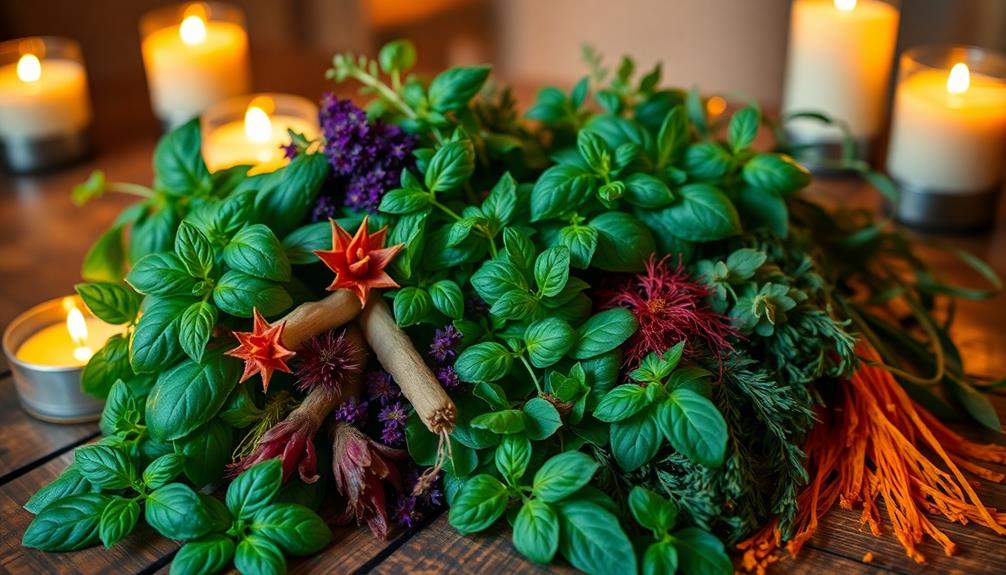
When considering herbal aphrodisiacs, Ginkgo Biloba and Red Ginseng stand out for their potential benefits.
Ginkgo Biloba may boost sexual excitement in women by improving blood flow, which is essential for a heightened experience, much like how certain dishes enhance meal enjoyment, such as Kawarma (Preserved Meat).
Red Ginseng has shown promise in enhancing desire and erectile function.
Both herbs have garnered attention for their roles in heightening sexual experiences, making them worth exploring.
Ginkgo Biloba Benefits
The allure of enhancing sexual importance often leads individuals to explore herbal options, and ginkgo biloba stands out among them. This ancient supplement, rooted in traditional Chinese medicine, is famed for its potential to enhance blood circulation and improve sexual function.
Additionally, incorporating certain foods, such as Dorayaki (Red Bean Pancake), into your diet may also contribute to overall well-being and liveliness, further supporting sexual health.
Here are some intriguing benefits of ginkgo biloba:
- It may increase blood flow to the genitals, which could heighten sexual arousal and excitement.
- Clinical studies reveal that around 84% of women reported an improved libido after taking ginkgo biloba for a specific period.
- Its blood-thinning properties might be beneficial, but caution is advised for those on anticoagulant medications.
While the benefits of ginkgo biloba are promising, it's important to note that further research is needed to fully validate its effectiveness as an aphrodisiac.
Understanding potential side effects or interactions is significant before incorporating it into your routine. If you're looking to boost your sexual function naturally, ginkgo biloba could be worth considering—just remember to consult with a healthcare professional to confirm it's right for you.
Ginseng's Impact on Desire
Ginseng, especially red ginseng, has garnered attention as a potent herbal aphrodisiac known for its ability to boost sexual desire. Traditionally used in Chinese medicine, ginseng is believed to enhance libido and improve sexual function.
Many cultures have celebrated the use of herbs, such as ginseng, to create unique dishes that may also contribute to enhancing sexual experiences, like the aromatic flavors found in Asian cuisine.
Studies have shown promising results, indicating that ginseng supplementation can lead to improved erectile function and increased sexual arousal.
Research suggests that ginseng may elevate nitric oxide levels in your body, which enhances blood flow to the genitals, potentially improving sexual desire. A systematic review of various studies found that ginseng supplementation markedly improved sexual desire and satisfaction for both men and women.
If you're considering adding ginseng to your routine, typical dosages range from 1 to 3 grams of the root per day. You might start noticing effects after several weeks of consistent use.
While ginseng is generally safe, it's important to consult with a healthcare provider before starting, especially if you're taking other medications.
Psychological Influence on Sexual Desire

Many people underestimate the power of psychology in shaping sexual desire, especially when it comes to foods traditionally deemed aphrodisiacs. The belief that certain foods can heighten arousal often creates a placebo effect, making you feel more stimulated simply because you expect to.
Consider these psychological factors at play:
- Mood and ambiance: The setting in which you enjoy these foods can greatly enhance your sexual desire.
- Symbolism: The sensual shapes and historical contexts of aphrodisiac foods can evoke feelings of attraction.
- Shared experiences: Openly discussing preferences while enjoying these foods can deepen emotional connections.
When you indulge in foods associated with aphrodisiacs, your brain may release endorphins and dopamine, chemicals linked to pleasure and reward. This further boosts your sexual desire, making the entire experience more intimate.
Risks and Safety Considerations
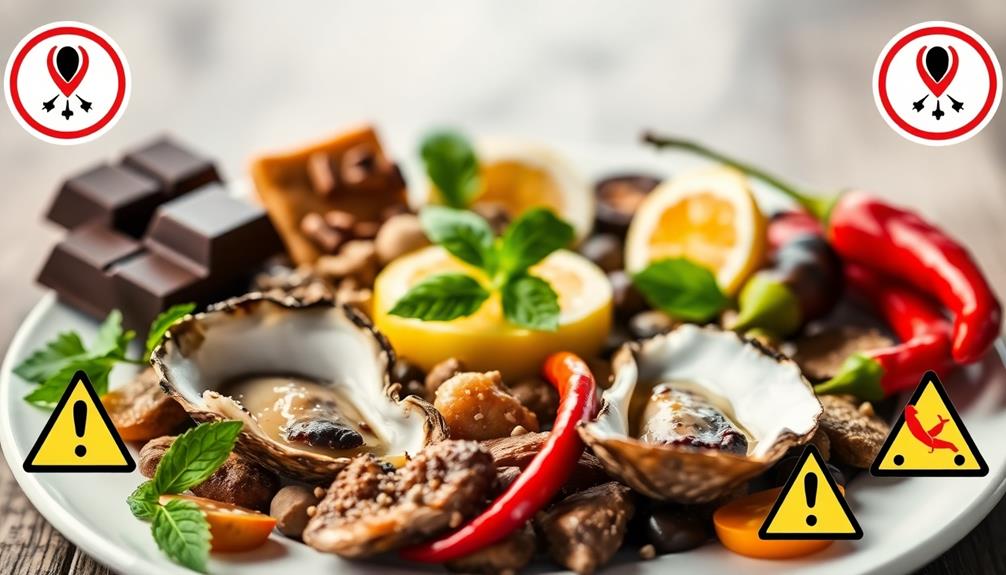
While indulging in aphrodisiac foods can be enticing, it's important to evaluate the associated risks and safety precautions. Some aphrodisiacs, like Spanish fly and mad honey, can lead to severe health issues, including kidney damage and heart problems. Similarly, herbal supplements such as yohimbe are linked to serious side effects, making it vital to consult a healthcare provider before using them.
Additionally, many purported aphrodisiacs lack scientific validation, which can lead to wasted resources or health risks if you rely on them without proper medical advice. Allergies and intolerances should also be considered when consuming specific foods believed to enhance libido, as they can trigger adverse reactions.
Here's a quick reference to keep in mind:
| Risks of Certain Aphrodisiacs | Safety Considerations |
|---|---|
| Kidney damage | Consult a healthcare provider |
| Heart problems | Be aware of allergies |
| Serious side effects | Verify scientific support |
| Wasted resources | Understand medication interactions |
| Adverse reactions | Prioritize informed choices |
Always prioritize your safety and well-being when exploring aphrodisiac foods.
Scientific Research on Aphrodisiacs
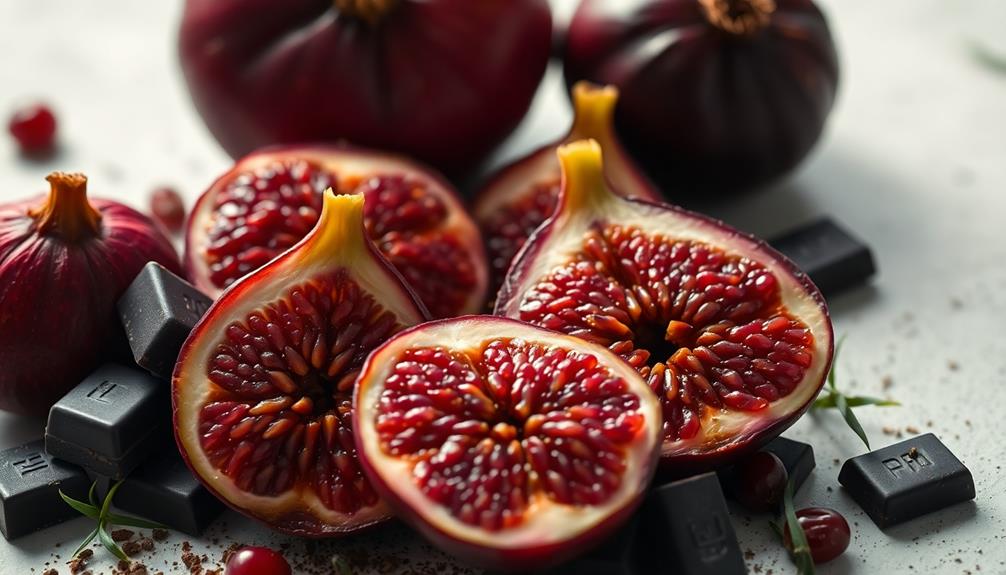
Scientific research on aphrodisiacs reveals fascinating insights into how certain foods can impact sexual desire and performance. You might be surprised to learn that scientific studies often highlight the psychological and physiological effects of these foods. For example, compounds found in maca and ginseng have shown potential to influence your libido.
Consider these findings:
- Daily consumption of pomegranate juice can elevate testosterone levels in both men and women, potentially enhancing sexual desire.
- Ginkgo biloba may improve sexual excitement in women by increasing blood flow to the genitals.
- While foods like oysters and dark chocolate are often touted for their aphrodisiac properties, scientific evidence supporting these claims is limited.
Interestingly, the placebo effect plays a significant role in how you perceive the effectiveness of aphrodisiacs. The anticipation of enhanced sexual experiences can lead to improved sexual satisfaction, regardless of the actual impact of the food.
Empowering Knowledge for Better Choices
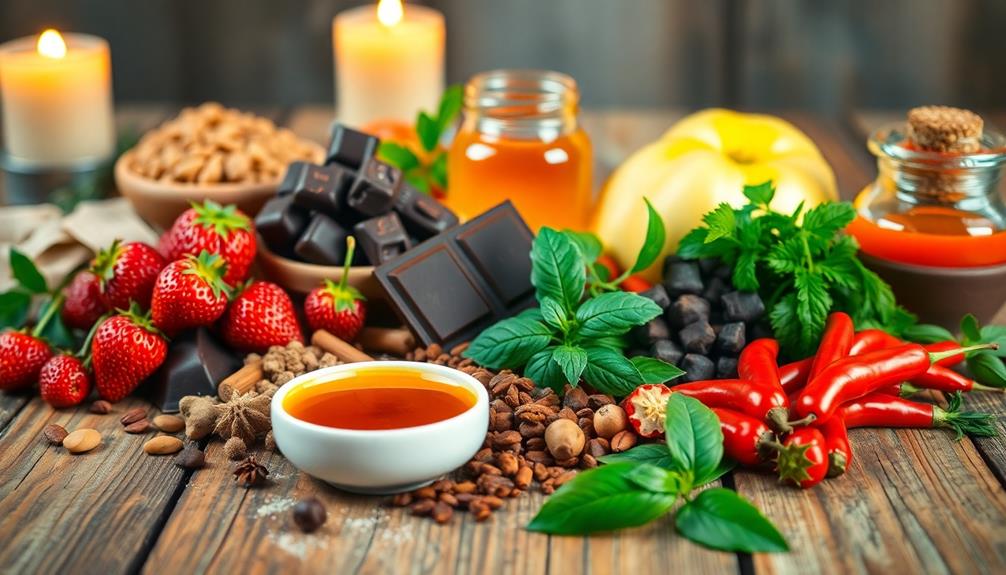
A deeper understanding of aphrodisiacs can empower you to make better dietary choices that enhance your sexual health and intimacy. By learning about the historical significance of these foods, like their ties to the Greek goddess Aphrodite, you can appreciate their cultural influence on your eating habits.
Knowledge of specific aphrodisiac foods, such as oysters for zinc or dark chocolate for mood enhancement, equips you to choose wisely. Additionally, recognizing how certain foods can impact your psychological state helps you set the right ambiance for romance.
Before diving into herbal options like ginseng or yohimbe, it's essential to be aware of potential side effects and interactions with medications. This guarantees that your choices are not only exciting but safe.
Accessing reliable studies on aphrodisiacs can further guide your dietary choices, promoting sexual health and intimacy. Here's a quick reference table to help:
| Food | Aphrodisiac Property | Benefits |
|---|---|---|
| Oysters | High in zinc | Boosts libido |
| Dark Chocolate | Mood-enhancing compounds | Increases pleasure |
| Ginseng | Herbal stimulant | Enhances energy and desire |
Frequently Asked Questions
Is There Science Behind Aphrodisiacs?
Yes, there's some science behind aphrodisiacs. Certain foods contain nutrients that may boost blood flow and overall health. The placebo effect also plays a role, as your anticipation can enhance your sexual experiences considerably.
Why Are Figs Aphrodisiacs?
Figs boost your stamina and support healthy ovulation with their amino acids and iron. Their unique shape and antioxidants improve blood circulation, enhancing sexual health and potentially increasing your desire and performance. Enjoy them regularly!
Conclusion
In the grand tapestry of love and desire, aphrodisiac foods weave vibrant threads that tantalize the senses. By understanding their history, nutritional value, and psychological impact, you can make empowered choices to spice up your romantic life. Whether it's a luscious strawberry or a dash of exotic spice, these foods can ignite passion and deepen connection. So, savor each bite and let the magic of these culinary delights awaken your inner desires, turning every meal into a celebration of love.



